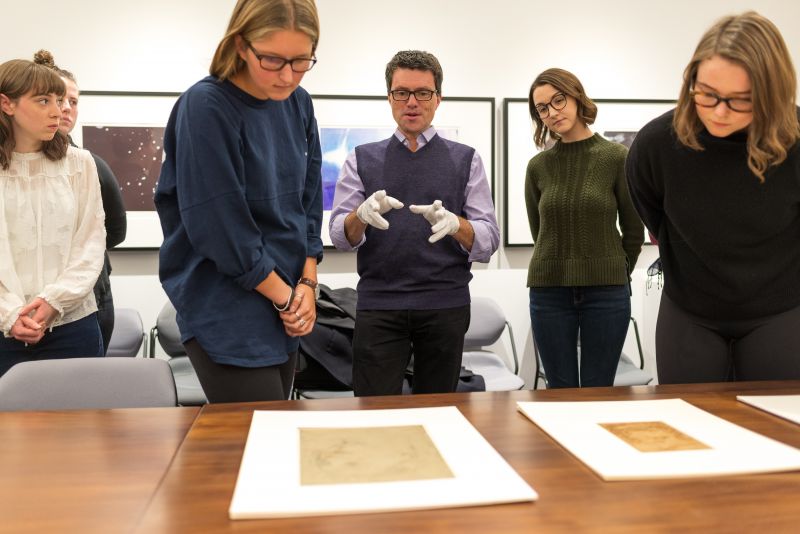Professor’s passion for art history motivates students

Queen’s University Professor Gauvin Bailey's passion for art history has led him to become one of the leading experts in Southern Baroque art in Europe and globally. His most recent endeavour is working as a consultant and author for a Latin American art exhibition at the Museo de Artes at the Universidad de los Andes in Santiago, Chile. We talked to him about his career and how this could motivate his current and future students.
Q: You are currently the consultant and catalogue co-author for an exhibition of Chilean sculpture at the Museo de Artes at the Universidad de los Andes in Santiago. How did you end up being selected for that position?
A: I was approached by the director of the Museo de Artes at the Universidad de los Andes, Marisol Richter Scheuch, while I was giving a public lecture on colonial Latin American art in Santiago in 2018. She was organizing a scholarly catalogue and exhibition of a collection of 56 nineteenth-century wooden religious sculptures from South-Central Chile that was a gift from a private donor and would have a permanent home in the museum, and she wanted to ask my opinion about the sculptures and to invite me to write the introduction to the catalogue.
The Holtz-Kähni Collection, as it is called, interested me very much as the sculptures were vernacular works made for people’s private shrines and were still being carved in the traditional style of the colonial era long after Chile had declared independence in 1810 (they range in date from the late 18th to early 20th century). While the metropolitan centres such as Santiago were abandoning traditional arts guilds in favour of formal academies on the European models (and importing artists from France, Spain, and Italy), these rural sculptors were preserving this lively tradition of local carving in their homes and villages. I work a lot with colonial Latin American sculpture (especially in Chile, Peru, Bolivia, and Paraguay) and what fascinated me was the persistence of this centuries-old tradition of carving into the modern era. It showed the perseverance of a people who did not want foreigners and academically-trained artists to tell them how to make art – a form of collective resistance. They are also really striking sculptures, with lots of character and vividness – even playfulness at times. Remarkably, these sculptures had never been studied before, even though they are critical part of the history of the art of Chile and Latin America in general. The exhibition opened this month and the book launch for the catalogue took place on 19 January, which was covered by national media.
Q: You are currently the Professor and Bader Chair in Southern Baroque Art. Tell me a little more about your career at Queen’s.
I came to Queen’s as the Bader Chair in Southern Baroque Art in 2011 after 15 years of teaching at universities in the United States and United Kingdom (most recently the University of Aberdeen). The Bader Chair position appealed to me because it allowed me to unite my two main interests, European Baroque and the arts of the Renaissance and Baroque eras in Latin America and in European colonies in Asia and Africa.
Since coming to Queen’s, I have published four books on Baroque and Rococo and their global reach and have also contributed to exhibitions at the Museum of Fine Arts, Boston, the Winterthur Museum, and the Museo Internacional del Barroco, Puebla (Mexico), writing catalogue chapters and entries and consulting on the choice of objects and themes. The research that goes into these books and exhibitions directly impacts my teaching at Queen’s as I incorporate this material into lectures and seminars. Students really appreciate things that are ‘hot off the press’ and ask penetrating questions about how a curator goes about putting together an exhibition and catalogue. I learn a lot from discussions with students in seminars and have mentioned them in the acknowledgments to my books.
Q: How can the work you’ve done inspire and motivate both current and future students?
A: Many students who major in Art History come here because they want a career in the arts, especially in a museum or art gallery. It is important for them to know that their professors have experience as guest curators, consultants, and catalogue authors for museum exhibitions because we can provide practical advice about the museum world and guide them in making career choices.
Q: What can a degree in Art History lead to?
Students who have graduated from our program work in museums, universities, and public and private cultural organizations around the world. Others have gone on to work at auction houses and commercial galleries, or in art law, journalism, art therapy, art business, or education. Even if they choose non-art-related fields they are enriched by their knowledge of the fine arts.
Read more about Dr. Bailey’s work with the United States Postal Service on this year’s Christmas stamp.

